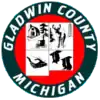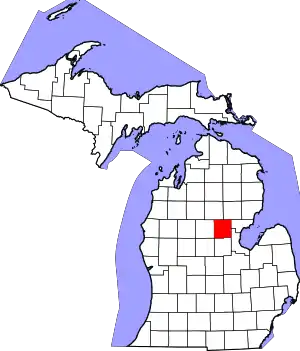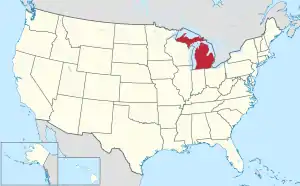Gladwin County | |
|---|---|
.jpg.webp) Gladwin County Courthouse in Gladwin | |
 Seal | |
 Location within the U.S. state of Michigan | |
 Michigan's location within the U.S. | |
| Coordinates: 43°59′N 84°23′W / 43.99°N 84.39°W | |
| Country | |
| State | |
| Founded | 1831 (created) 1875 (organized)[1] |
| Named for | Henry Gladwin |
| Seat | Gladwin |
| Largest city | Gladwin |
| Area | |
| • Total | 516 sq mi (1,340 km2) |
| • Land | 502 sq mi (1,300 km2) |
| • Water | 14 sq mi (40 km2) 2.7% |
| Population (2020) | |
| • Total | 25,386 |
| • Density | 51/sq mi (20/km2) |
| Time zone | UTC−5 (Eastern) |
| • Summer (DST) | UTC−4 (EDT) |
| Congressional district | 2nd |
| Website | www |
Gladwin County is a county located in the U.S. state of Michigan. As of the 2020 Census, the population was 25,386.[2] The county seat is Gladwin.[3]
History
Prehistory
Gladwin County is a headwaters area. Most of the water that flows out of the county via the Tittabawassee River comes from Gladwin County, only a very small portion flows in from Clare or Roscommon counties. Native Americans crossed this area, and even spent summers here where the fishing was good and summer berries plentiful.
Research is underway to determine the importance of an ancient trail that was noted by the crew of the 1839 re-survey of Township 17 north Range 2 west, which later became Beaverton Township. The eastern terminus of the "Muskegon River Trail" was plotted at the confluence of the three branches of the Tobacco (Assa-mo-quoi-Sepe) River in the northwest corner of Section 12. It is possible that an early cross-country route from Saginaw Bay to Lake Michigan proceeded up the Saginaw, Tittabawassee, and Tobacco Rivers to a point west across Ross Lake from the Beaverton City Cemetery. At that point, the canoes would be portaged along the trail to the Muskegon River, then floated down to Lake Michigan.
Many native artifacts have been found along that route that attest to seasonal occupation, but so far no signs have been found to indicate a permanent settlement.
European arrival
The earliest documented visitors to the area were surveyors who platted the lands under provision of the 1787 Northwest Ordinance. Most of the early work was completed during the 1830s, although some of the survey work was faulty - the surveyors reportedly doubted that the area would ever be settled.
The earliest census to mention residents in the area was in 1860.
The county is named for Henry Gladwin,[4] British military commandant at Detroit in 1763 during Pontiac's War. The county was set off and named in 1831, and its government was organized in 1875.[1]
Sesquicentennial
The year 2011 marked 150 years since the first permanent settler of record, Marvel Secord, took up residence along the Tittabawassee River in what is now Secord Township. He was a trapper and trader who provided supplies to lumbering camps in the area. Another man, William Brayton, may have been an earlier settler; the 1860 census listed 14 residents, including two families with children. Of these, 11 were associated with lumbering camps that had begun to appear that year, and three were listed as "hunters." One of the "day laborers" at a camp had brought his wife to the area. The first issue of the Gladwin County Record (1878) mentions his 20 acres (8.1 hectares) of wheat under cultivation. His stepson, Dr. Russell E. Finch arrived in the area in 1875, becoming the county's first physician. William Brayton died in 1895. His claim to being the first permanent settler appears valid, except that just before the 1880 census was taken he and his wife went to Lynn, Massachusetts to care for his dying father. He returned to Gladwin after settling his father's estate in 1882, thus missing being included in the Gladwin County census for 1880.
Geography
According to the U.S. Census Bureau, the county has a total area of 516 square miles (1,340 km2), of which 502 square miles (1,300 km2) is land and 14 square miles (36 km2) (2.7%) is water.[5] It is the second-smallest county in Michigan by total area. Gladwin County is sometimes considered to be a part of Central Michigan, and at other times is included in Northern Michigan.
Major highways
 M-18 runs north–south through the western part of the county. It runs south along the western county line from the county's northwestern corner for five miles (8.0 km) then runs east and south to Gladwin, then west and south to Beaverton. It exits the county six miles (9.7 km) from the southwestern county corner, running to an intersection with US 10.
M-18 runs north–south through the western part of the county. It runs south along the western county line from the county's northwestern corner for five miles (8.0 km) then runs east and south to Gladwin, then west and south to Beaverton. It exits the county six miles (9.7 km) from the southwestern county corner, running to an intersection with US 10. M-30 enters the northeastern part of county two miles (3.2 km) south of the northeastern corner. It runs westerly through the northern part of county, then turns to run south through the center part of county. The highway passes White Star and Billings before exiting the south county line near its midpoint.
M-30 enters the northeastern part of county two miles (3.2 km) south of the northeastern corner. It runs westerly through the northern part of county, then turns to run south through the center part of county. The highway passes White Star and Billings before exiting the south county line near its midpoint. M-61 runs east–west through center part of county and passes Gladwin and White Star.
M-61 runs east–west through center part of county and passes Gladwin and White Star.
County designated highways
Adjacent counties
- Ogemaw County – northeast
- Arenac County – east
- Bay County – southeast
- Midland County – south
- Clare County – west
- Isabella County – southwest
- Roscommon County – northwest
Demographics
| Census | Pop. | Note | %± |
|---|---|---|---|
| 1880 | 1,127 | — | |
| 1890 | 4,208 | 273.4% | |
| 1900 | 6,564 | 56.0% | |
| 1910 | 8,413 | 28.2% | |
| 1920 | 8,827 | 4.9% | |
| 1930 | 7,424 | −15.9% | |
| 1940 | 9,385 | 26.4% | |
| 1950 | 9,451 | 0.7% | |
| 1960 | 10,769 | 13.9% | |
| 1970 | 13,471 | 25.1% | |
| 1980 | 19,957 | 48.1% | |
| 1990 | 21,896 | 9.7% | |
| 2000 | 26,023 | 18.8% | |
| 2010 | 25,692 | −1.3% | |
| 2020 | 25,386 | −1.2% | |
| US Decennial Census[6] 1790-1960[7] 1900-1990[8] 1990-2000[9] 2010-2018[2] | |||
As of the 2000 United States Census,[10] of 2000, there were 26,023 people, 10,561 households, and 7,614 families in the county. The population density was 51 people per square mile (20 people/km2). There were 16,828 housing units at an average density of 33 per square mile (13/km2). The racial makeup of the county was 97.65% White, 0.13% Black or African American, 0.56% Native American, 0.27% Asian, 0.02% Pacific Islander, 0.31% from other races, and 1.06% from two or more races. 0.96% of the population were Hispanic or Latino of any race. 28.1% were of German, 11.5% American, 11.1% English, 9.4% Irish, 7.3% Polish and 6.4% French ancestry according to Census 2000. 96.3% spoke English, 1.7% German and 1.1% Spanish as their first language.
There were 10,561 households, out of which 27.10% had children under the age of 18 living with them, 60.50% were married couples living together, 8.00% had a female householder with no husband present, and 27.90% were non-families. 24.00% of all households were made up of individuals, and 11.20% had someone living alone who was 65 years of age or older. The average household size was 2.43 and the average family size was 2.85.
The county population contained 23.20% under the age of 18, 6.50% from 18 to 24, 24.20% from 25 to 44, 27.80% from 45 to 64, and 18.30% who were 65 years of age or older. The median age was 42 years. For every 100 females there were 98.50 males. For every 100 females age 18 and over, there were 95.30 males.
The median income for a household in the county was $32,019, and the median income for a family was $37,090. Males had a median income of $33,871 versus $21,956 for females. The per capita income for the county was $16,614. About 10.40% of families and 13.80% of the population were below the poverty line, including 19.40% of those under age 18 and 7.30% of those age 65 or over.
Government
Gladwin County has been reliably Republican from the beginning. Since 1884, the Republican Party nominee has carried the county vote in 85% of the elections (29 of 35 elections).
| Year | Republican | Democratic | Third party | |||
|---|---|---|---|---|---|---|
| No. | % | No. | % | No. | % | |
| 2020 | 9,893 | 67.69% | 4,524 | 30.95% | 198 | 1.35% |
| 2016 | 8,124 | 64.77% | 3,794 | 30.25% | 624 | 4.98% |
| 2012 | 6,661 | 52.94% | 5,760 | 45.78% | 162 | 1.29% |
| 2008 | 6,391 | 48.27% | 6,590 | 49.77% | 260 | 1.96% |
| 2004 | 6,770 | 51.18% | 6,343 | 47.95% | 114 | 0.86% |
| 2000 | 5,743 | 49.39% | 5,573 | 47.92% | 313 | 2.69% |
| 1996 | 3,670 | 34.32% | 5,494 | 51.38% | 1,528 | 14.29% |
| 1992 | 3,616 | 33.56% | 4,457 | 41.36% | 2,703 | 25.08% |
| 1988 | 4,746 | 52.82% | 4,164 | 46.34% | 76 | 0.85% |
| 1984 | 5,401 | 61.07% | 3,368 | 38.08% | 75 | 0.85% |
| 1980 | 4,509 | 51.09% | 3,733 | 42.30% | 583 | 6.61% |
| 1976 | 3,794 | 50.14% | 3,719 | 49.15% | 54 | 0.71% |
| 1972 | 3,484 | 61.94% | 2,016 | 35.84% | 125 | 2.22% |
| 1968 | 2,840 | 56.55% | 1,668 | 33.21% | 514 | 10.23% |
| 1964 | 1,941 | 41.45% | 2,725 | 58.19% | 17 | 0.36% |
| 1960 | 3,282 | 69.65% | 1,424 | 30.22% | 6 | 0.13% |
| 1956 | 3,121 | 73.47% | 1,117 | 26.29% | 10 | 0.24% |
| 1952 | 3,031 | 75.85% | 936 | 23.42% | 29 | 0.73% |
| 1948 | 2,062 | 66.43% | 963 | 31.02% | 79 | 2.55% |
| 1944 | 2,457 | 70.93% | 985 | 28.44% | 22 | 0.64% |
| 1940 | 2,741 | 67.78% | 1,294 | 32.00% | 9 | 0.22% |
| 1936 | 1,645 | 49.21% | 1,533 | 45.86% | 165 | 4.94% |
| 1932 | 1,378 | 43.86% | 1,661 | 52.86% | 103 | 3.28% |
| 1928 | 1,795 | 83.76% | 341 | 15.91% | 7 | 0.33% |
| 1924 | 1,908 | 78.36% | 255 | 10.47% | 272 | 11.17% |
| 1920 | 1,687 | 78.68% | 313 | 14.60% | 144 | 6.72% |
| 1916 | 935 | 52.88% | 729 | 41.23% | 104 | 5.88% |
| 1912 | 638 | 39.07% | 331 | 20.27% | 664 | 40.66% |
| 1908 | 1,168 | 71.35% | 386 | 23.58% | 83 | 5.07% |
| 1904 | 1,093 | 79.49% | 231 | 16.80% | 51 | 3.71% |
| 1900 | 978 | 75.23% | 299 | 23.00% | 23 | 1.77% |
| 1896 | 748 | 67.09% | 323 | 28.97% | 44 | 3.95% |
| 1892 | 531 | 60.76% | 325 | 37.19% | 18 | 2.06% |
| 1888 | 525 | 58.79% | 357 | 39.98% | 11 | 1.23% |
| 1884 | 288 | 55.49% | 213 | 41.04% | 18 | 3.47% |
The county government operates the jail, maintains rural roads, operates the major local courts, records deeds, mortgages, and vital records, administers public health regulations, and participates with the state in the provision of social services. The county board of commissioners controls the budget and has limited authority to make laws or ordinances. In Michigan, most local government functions — police and fire, building and zoning, tax assessment, street maintenance, etc. — are the responsibility of individual cities and townships.
Elected officials
- Prosecuting Attorney: Mark Toez
- Sheriff: Michael Shea
- County Clerk: Karrie Hulme
- County Treasurer: Christy VanTiem
- Register of Deeds: Ann Manning-Clayton
- Drain Commissioner: Terry Walters
- Road Commissioners: Chuck Hinman
- County Administrator: Mark Justin
- Commissioner Dist. 1 – Kyle Grove
- Commissioner Dist. 2 – Ron Taylor
- Commissioner Dist. 3 – Michael Szuch
- Commissioner Dist. 4 – Karen Moore
- Commissioner Dist. 5 – Rick Grovel[13]
(information as of 2021)
Communities

Cities
Civil townships
Unincorporated communities
Ghost town
Education
The Clare-Gladwin Regional Education Service District, based in Clare, services the students in the county along with those of Clare County. The intermediate school district offers regional special education services, early education and after-school programs, and technical career pathways for students of its districts.[14]
Gladwin County is served by the following regular public school districts:[15]
- Beaverton Schools
- Gladwin Community Schools
Gladwin County has the following private schools:[16]
See also
References
- 1 2 "Bibliography on Gladwin County". Clarke Historical Library, Central Michigan University. Retrieved January 19, 2013.
- 1 2 "State & County QuickFacts". U.S. Census Bureau. Retrieved September 15, 2021.
- ↑ "Find a County". National Association of Counties. Retrieved June 7, 2011.
- ↑ Gannett, Henry (1905). The Origin of Certain Place Names in the United States. Govt. Print. Off. p. 138.
- ↑ "2010 Census Gazetteer Files". US Census Bureau. August 22, 2012. Archived from the original on November 13, 2013. Retrieved September 21, 2014.
- ↑ "US Decennial Census". US Census Bureau. Retrieved September 21, 2014.
- ↑ "Historical Census Browser". University of Virginia Library. Retrieved September 21, 2014.
- ↑ "Population of Counties by Decennial Census: 1900 to 1990". US Census Bureau. Retrieved September 21, 2014.
- ↑ "Census 2000 PHC-T-4. Ranking Tables for Counties: 1990 and 2000" (PDF). US Census Bureau. Retrieved September 21, 2014.
- ↑ "U.S. Census website". US Census Bureau. Retrieved January 31, 2008.
- ↑ US Election Atlas
- ↑ The leading "other" candidate, Progressive Theodore Roosevelt, received 549 votes, while Socialist candidate Eugene Debs received 85 votes, Prohibition candidate Eugene Chafin received 25 votes, and Socialist Labor candidate Arthur Reimer received 5 votes.
- ↑ Departments Gladwin County website (accessed 2 October 2018)
- ↑ "CGRESD: What do we do?". Clare-Gladwin Regional Education Service District. Retrieved July 14, 2023.
- ↑ National Center for Education Statistics. "Search for Public School Data: Gladwin County, MI". Institute of Education Sciences. Retrieved July 16, 2023.
- ↑ National Center for Education Statistics. "Search for Private Schools: Gladwin County, MI". Institute of Education Sciences. Retrieved July 16, 2023.
External links
- Gladwin County government
- Gladwin City government
- Beaverton City government
- Gladwin County Chamber of Commerce
- Gladwin County Economic Development Corp.
- Gladwinmi.com (hosted by the Gladwin County Record)
- "Bibliography on Gladwin County". Clarke Historical Library, Central Michigan University.
- Gladwin County Historical Society
- Gladwin County District Library
- Gladwin Community Schools
- Beaverton Rural Schools